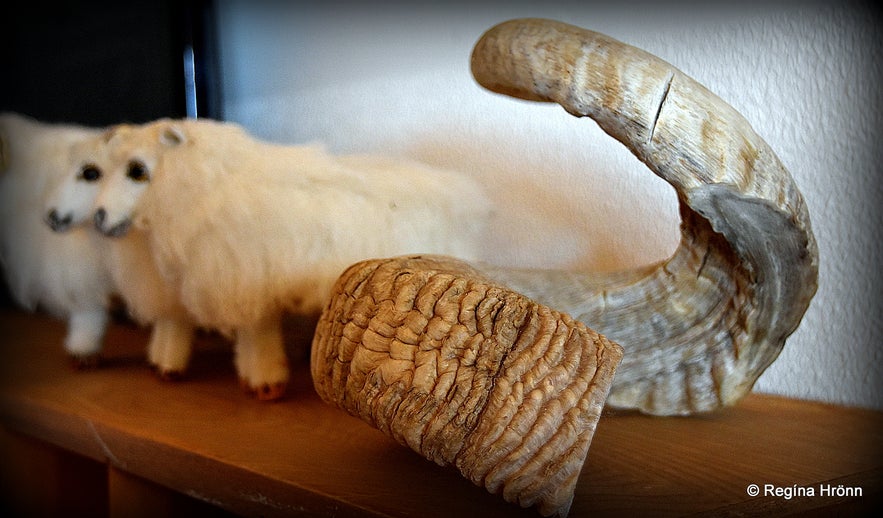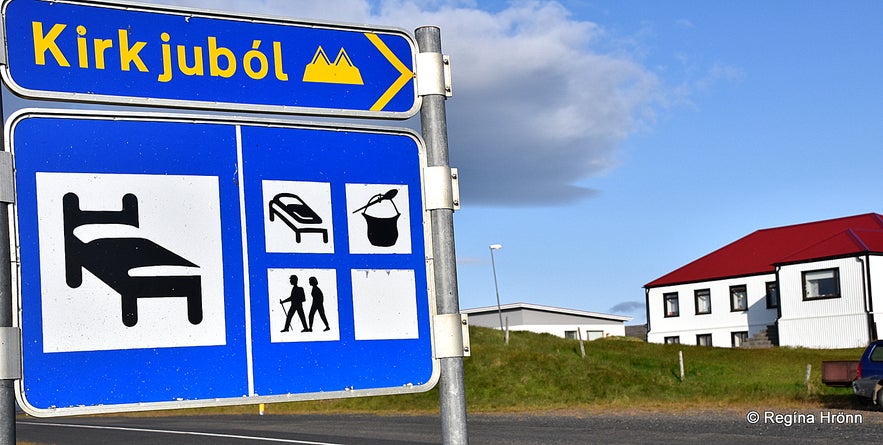
3 Days of fun at Kirkjuból and the Sheep Farming Museum at Strandir in the Westfjords Region
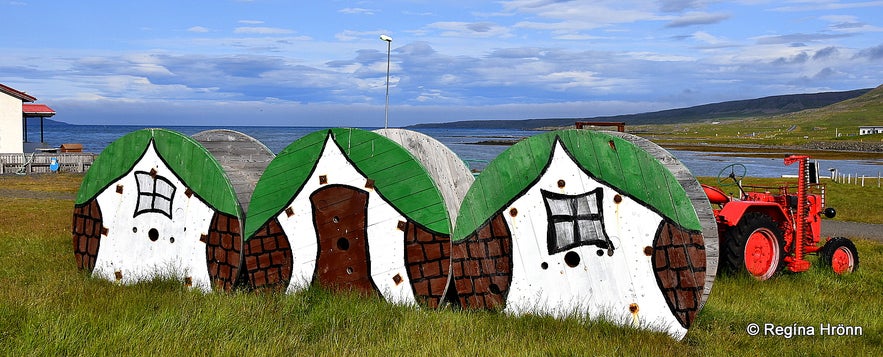
I got the opportunity to stay at Kirkjuból at Strandir in the Westfjords Region of Iceland for two years in a row, when my husband was taking part for 3 days in the children's festival Náttúrubarnahátíð at Sauðfjársetur – the Sheep Farming Museum at Strandir.
All the time during this wonderful children‘s festival we stayed at the guesthouse Kirkjuból and got to know the family who lives there and runs both the festival and the Sheep Farming Museum.
Top photo: Sauðfjársetur - the Sheep farming museum
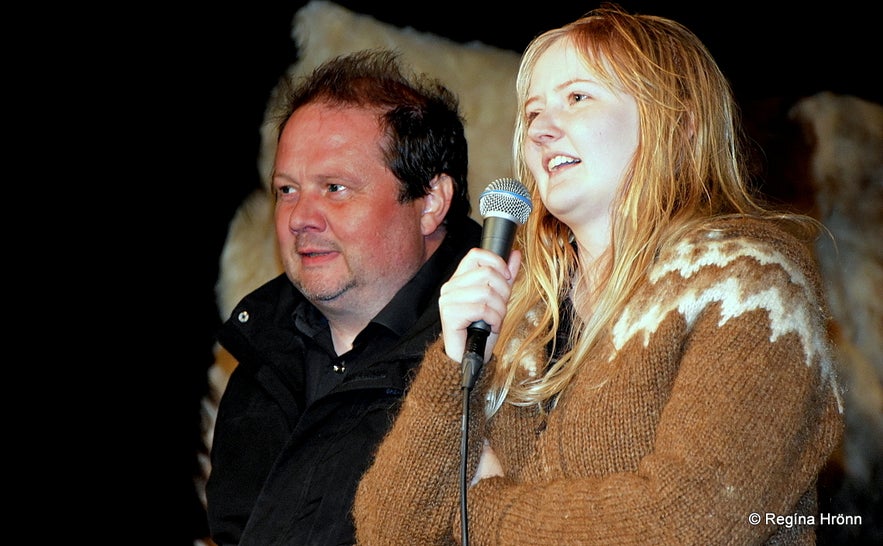
Jón and Dagrún at Sauðfjársetur - the Sheep farming museum
And what a treat it was to get to know these people and get acquainted with the wonderful work they do. I had already stayed at Hólmavík (12 km away) while my husband was taking part in another children‘s festival at Hólmavík and explored the remote and sparsely populated Strandir.
In this travel-blog, I will tell you about the Sheep Farming Museum, the Kaffi Kind café, and Kirkjuból at Strandir, which I was visiting for the first time.
The museum is a non-profit organization run by the family, Jón Jónsson, his wife Ester Sigfúsdóttir, whos is the managing director of the museum, and their daughter Dagrún. Ester was so busy in the kitchen during the festival, that I, unfortunately, couldn't take a photo of her.
I spent some time with Jón and Dagrún, who are both ethnologists and very knowledgeable about Iceland, Icelandic folklore, and Sagas.
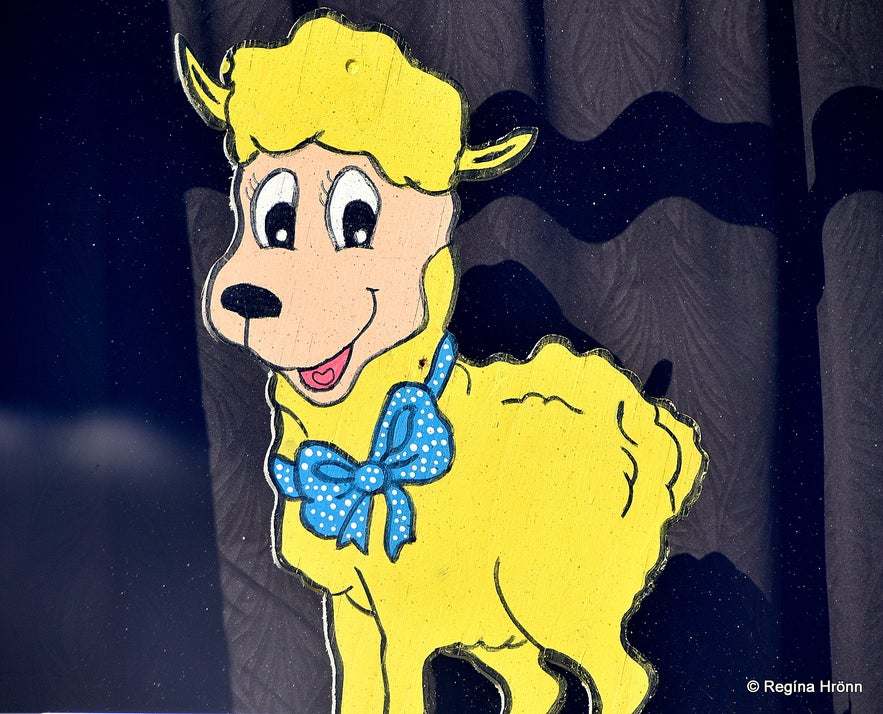
A cute lamb at Sauðfjársetur - the Sheep farming museum
Ethnology is something I have wanted to study for a very long time at the University of Iceland but never got the opportunity to do so. To make up for it I read a lot of folklore and the Sagas, and include as much of it in my travel-blogs as I can as it enriches my travels in Iceland.
And I hope that by reading my travel-blogs it enriches your experience of Iceland as well :)
Sauðfjársetrið – the Sheep Farming Museum
A sheep horn at the museum
Sauðfjársetrið – the Sheep Farming Museum was founded as a counterpart for the close-by Museum of Icelandic Witchcraft and Sorcery in Hólmavík.
Jón was also instrumental in founding that very popular museum up in Hólmavík. Seeing that a great part of the witch-craze in Iceland took place here at Strandir, then this area is a fitting place for such a museum. That museum attracts about 18,000 visitors annually, mainly foreign tourists.
The infamous necropants have made that museum well-known worldwide, and I have written another travel-blog with photos of the necropants: The Museum of Icelandic Witchcraft and Sorcery at Hólmavík in the Westfjords Region.
Sauðfjársetrið - the Sheep farming museum
Now let's have a look at what the lovely Sheep Farming Museum has got to offer.
At the museum, you will get to know all about the Icelandic sheep, but without them, Icelanders would not have been able to survive here through the centuries.
Around 6,000 people pay the Sheep Farming Museum a visit every year, of which there are 30% foreign visitors, Jón told me.
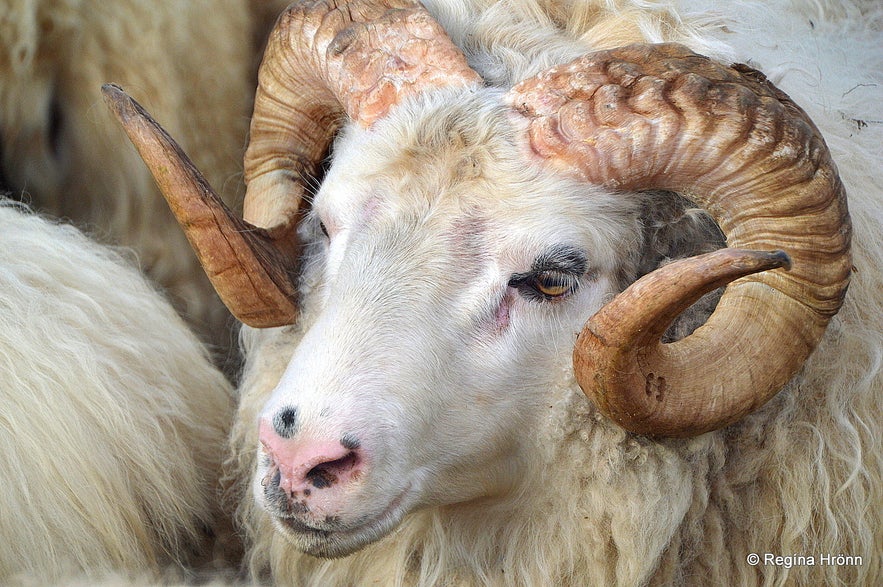
Icelandic sheep
The Icelandic sheep are to a degree descendants of the settlement sheep, which the Vikings brought with them to Iceland. In the summertime the Icelandic sheep roam free in the countryside; these stubborn little sheep are independent and lack the horde mentality.
The sheep are then rounded up in autumn, where each farmer finds his sheep.
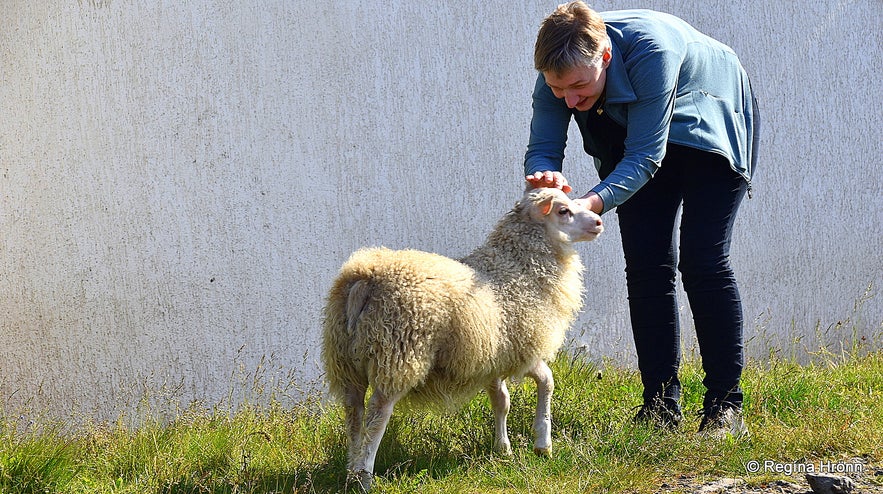
The bottle lamb at the Sheep Farming Museum
The exhibition at the Sheep Farming Museum is called Sheep in the story of Iceland. At the exhibition, you will see how every part of the sheep was used, the meat, the head, the tallow, and much more to keep us Icelanders alive.
And the wool kept Icelanders warm, so we owe our lives to the Icelandic sheep. Most Icelanders own lopapeysa, the warm Icelandic woolen sweater, which you can see me wearing in some of the photos in this travel-blog.
The exhibition at the Sheep Farming Museum is in Icelandic, and foreign visitors will get good information in English and other languages and can be guided through the exhibition.
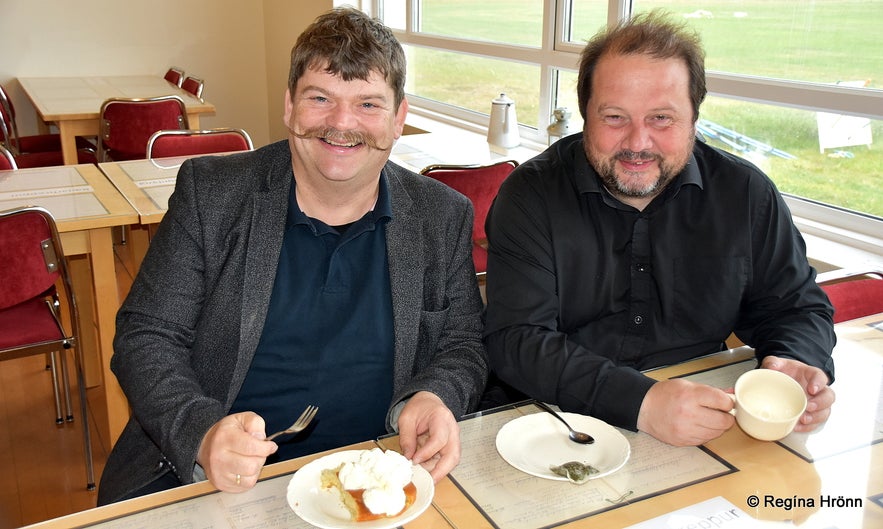
My Jón and Ester's Jón at the museum café :)
The Sheep Farming Museum is located in Sævangur, the former local community centre, where you can also get local treats at their coffee bar Kaffi Kind (the Sheep café), including Eftirlæti bóndans – the Farmer‘s favourite dish (rye bread with smoked lamb, "skonsa" with smoked salmon and cake).
On the menu is also ice cream from the dairy farm Erpsstaðir in Dalir, which is a must-stop for Icelanders while driving up to Strandir.
The café is open at the same time as the museum - every day in the summer months from 10-18.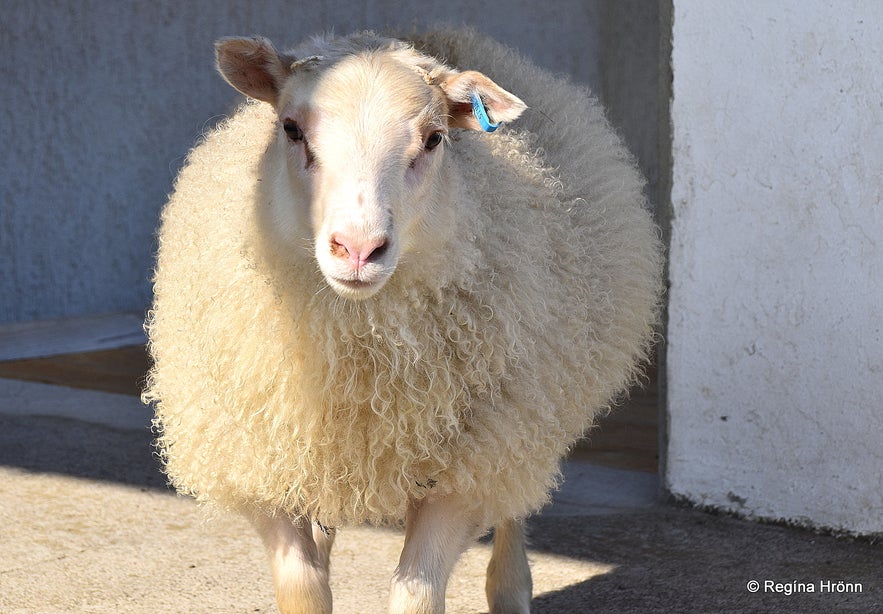
The bottle lamb at the Sheep Farming Museum
Children will love this museum as one of the attractions at the museum is the heimalningur – the bottle lamb, which is fed milk from a bottle and will follow you around like a dog.
This is the closest I have been to a sheep in my life, as I am born and bred in Reykjavík, where there are no sheep roaming around. And as sheep in the countryside get spooked very easily and run away, then I loved my visit to the Sheep Farming Museum as there I was followed around by this bottle lamb which bleated at me non-stop.
It even allowed me to pet it, so precious. But what it was after was the bottle, as visitors can get the change to bottle-feed the lamb.
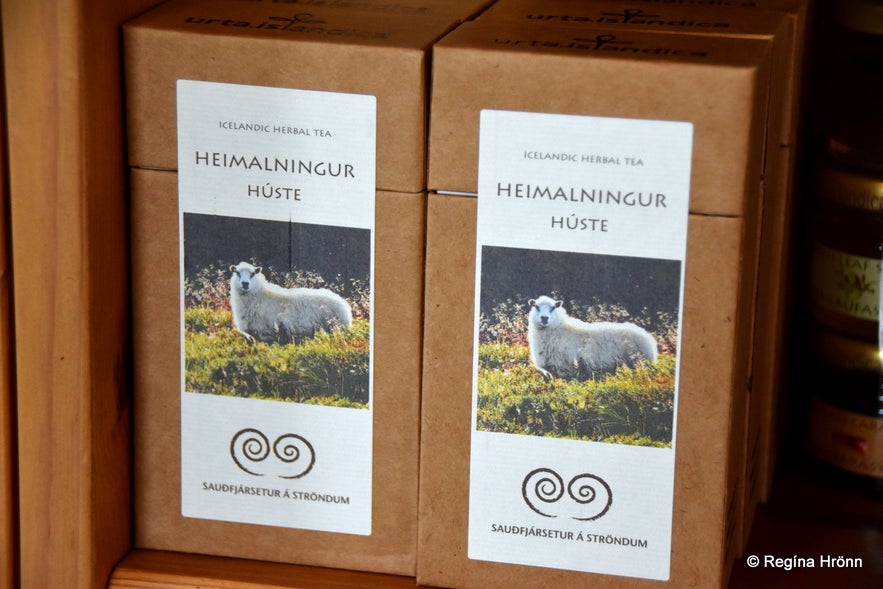
Heimalningur húste - Icelandic herbal tea
You can get Heimalningur House tea blend at the museum coffee bar and at the handicraft store in the lobby. It is delicious, made from Icelandic handpicked herbs; birch, thyme, and Iceland Moss, all of which are well-known in Iceland for their medical use. I bought a box to bring back home.
I also found this T-shirt below at the souvenir shop with this unique text printed on it, which I am sure that no foreigner will understand. It reads Sauðfjárveikivarnir - lokið hliðinu which means Sheep Disease Prevention - Close the Gate in case you were wondering ;)
Always remember to close the gate behind you when encountering a gate in the Icelandic countryside, and especially if you see this sign on the gate.

A T-shirt for sale at the museum
I am pretty sure that if it weren't for the Icelandic sheep there would be no Icelanders as these tough little sheep have kept us alive through the centuries and played a big part in the survival and history of Iceland.
As I mention earlier then the sheep roam free in Iceland during the summer months. Take that into account when driving on the roads in the countryside.
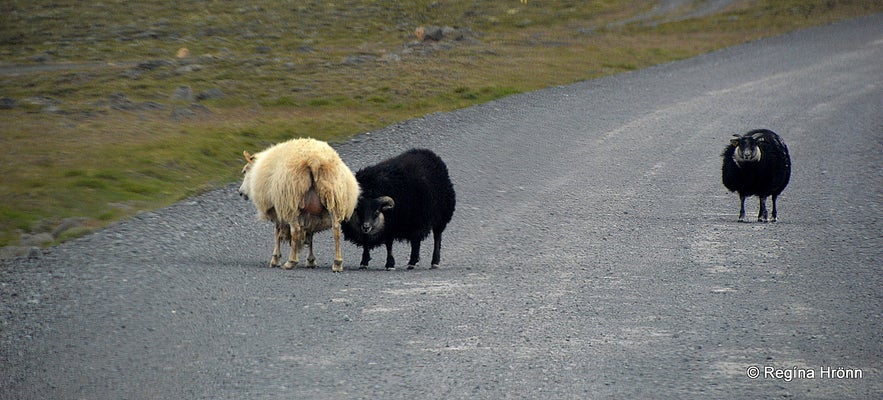
Sheep on the road - the one to the right stayed behind in the middle of the road and was ready to attack the car ;)
A sheep might be strolling on the road with her lambs, or jump unexpectedly on the road. Be extra careful when you see a lamb on one side and its mother on the other side as the lamb will invariably jump up on the road to join its mother.
The sheep will get spooked by the car and run in all directions, but the little lamb in my photo above, which I took on the Kjölur route, stayed behind and defied us ;)
The Exhibition about Enchanted Spots in Strandir
I love the Exhibition about Enchanted Spots in Strandir at the museum :)
In one part of the Sauðfjársetur - Sheep Farming Museum, you will find a very interesting exhibition; the Exhibition about Enchanted Spots in Strandir with a guide in English and other languages.
As you, who read my travel-blog, know then I search for enchanted spots and elf-locations in Iceland to show to you. So this exhibition was right up my alley :)
As I told you earlier in this travel-blog, then both father and daughter are very knowledgeable ethnologists and Dagrún temporarily added the exhibition to the museum. But it is way too interesting to remove it and it will most likely become a part of the museum.
Don't miss it, it is so interesting reading about these enchanted spots in Strandir, of which there are quite a few.
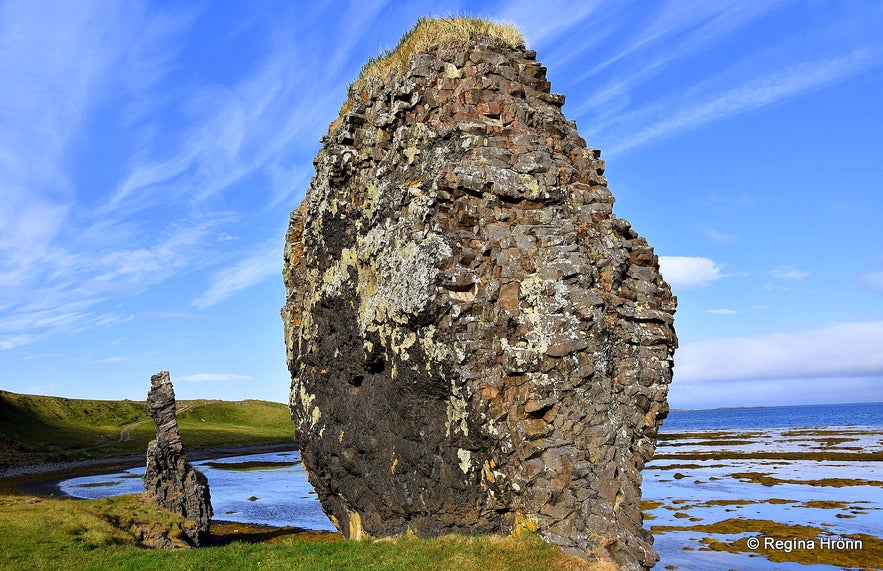
The trolls in Drangavík in Kollafjörður who wanted to separate the Westfjords Region from the mainland of Iceland
Not far from the museum I visited one such location and got directions from the proprietors of the museum. It is a troll spot, where you can find 2 of the Westfjord trolls who wanted to separate the Westfjords Region from the mainland of Iceland.
My next travel-blog is about these Icelandic trolls:
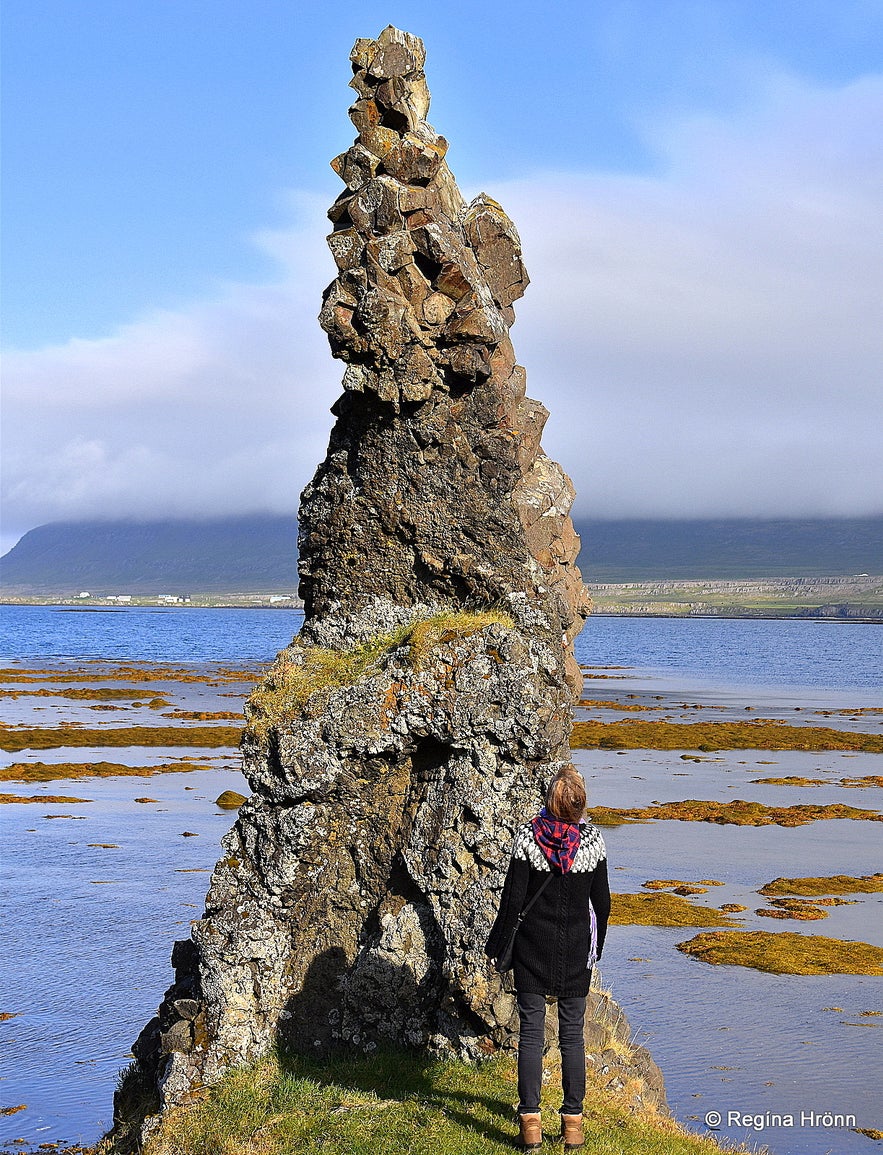
In front of either the female troll or the male troll
I also visited Kastalinn - the Castle, an enchanted elf-location in the vicinity of the Westfjord trolls, which I found out about at this exhibition. I would not have known about it if I hadn't visited this exhibition and I was eager to visit it.
Kastalinn - the Castle is inhabited by the elves and it was forbidden to mow it like so many other elf spots all around Iceland, as the grass belongs to the elves. Children were allowed to play by it though, but racket and disrespect in such places are not allowed.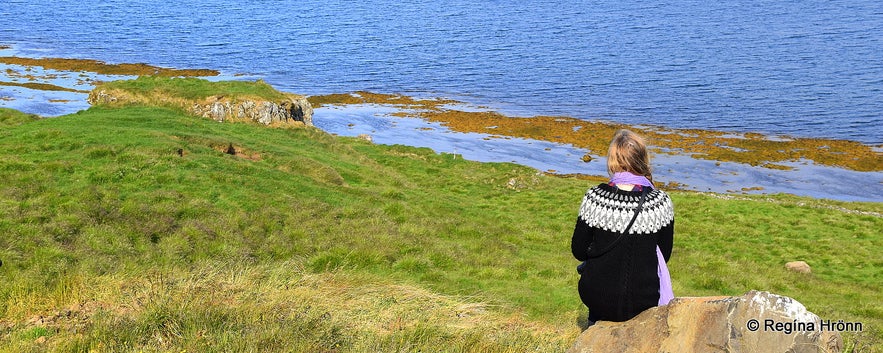
Kastalinn - the Castle. I didn't approach it but sat down on a rock and watched it and sent good vibes to the elves.
In 1914 a new owner of the farm Hlíð on this spot in Kollafjörður didn't listen to any warnings about Kastalinn being enchanted - and mowed it!
He had such bad luck with his livestock the following winter (which is a well-known sign of the revenge of the elves) that he never moved it again and it has not been mowed since.
Bird-life by the Sheep-Farming Museum and Kirkjuból
Settlement chicken at the Sheep farming museum
During your visit to the Sheep Farming Museum, you will notice some colourful chickens roaming around. They are landnámshænur - the settlement chicken, the descendants of the chicken which the Vikings brought with them to Iceland.
There are many other bird species in this area as the name Kollafjörður (the next fjord to Steingrímsfjörður) indicates; the Fjord of the Eider Duck. You will see a myriad of birds here by the sea, amongst them, teista - the black guillemot.
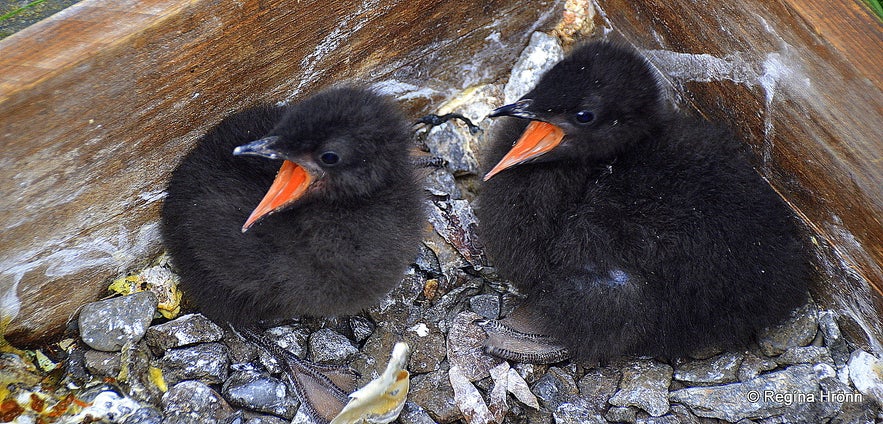
Black guillemot chics on the beach
I must mention my main enemy amongst the Icelandic migratory birds, krían - the Arctic tern - which will attack fearlessly to keep you well away from their nest. It is a very irritating bird in my opinion and never leaves me alone.
It has also caused accidents on the road as when we were driving from the museum to Kollafjörður to see the trolls, a jeep with tourists approached us. 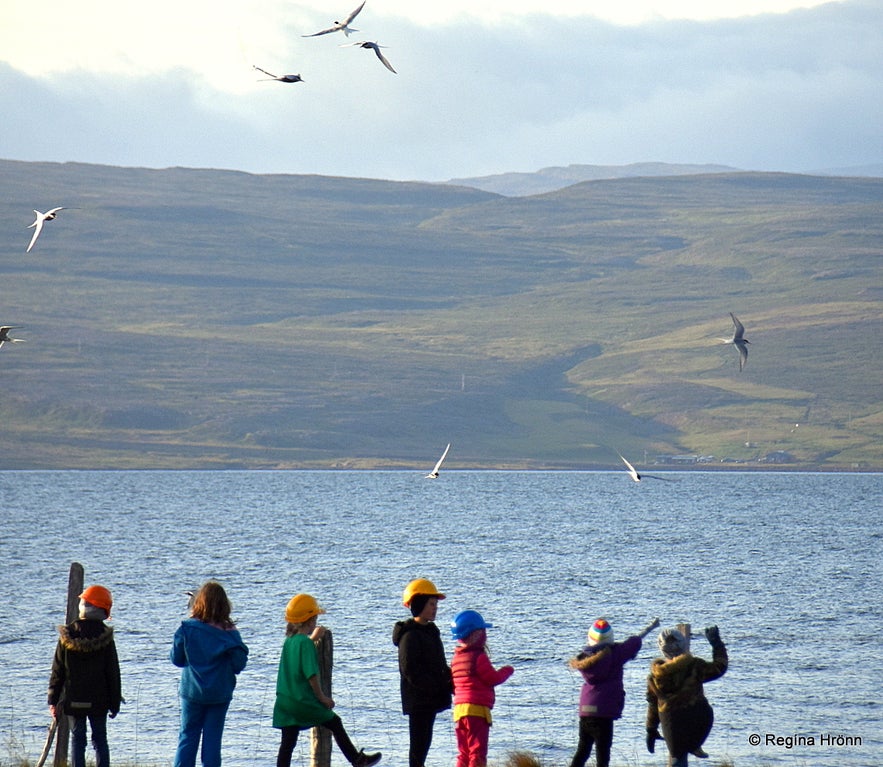
So be aware of that bird!
The driver got distracted looking at a flock of Arctic terns and drove straight off the road at full speed! Luckily nobody got hurt and luckily it didn't crash into us or anything else!
This is how the Icelandic kids at the children's festival defended themselves from the attacks - with helmets - so that they could play outside by the museum.
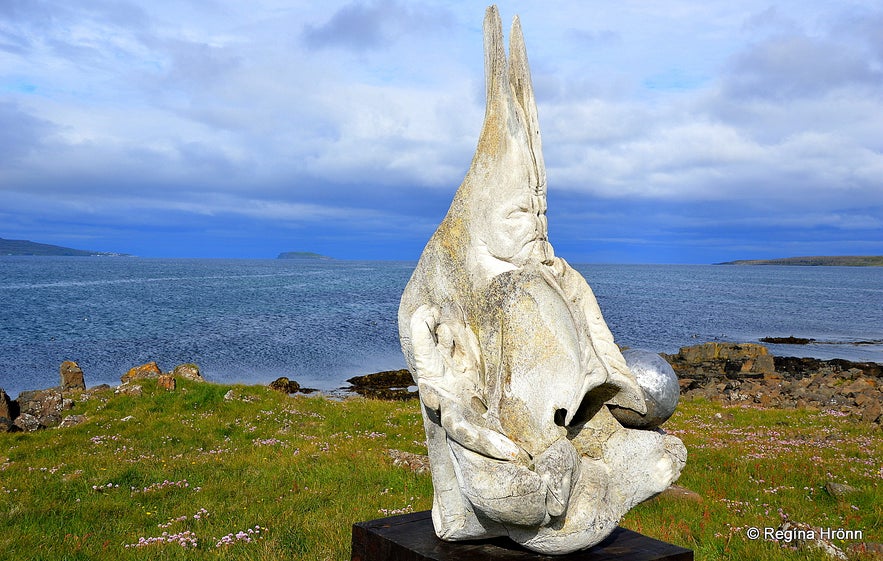
Njörður at Orrustutangi spit
When we visited Sævangur in the summer of 2020 interesting artworks had been erected by the Sjávarslóð trail at Orrustutangi spit. Above is Njörður by the artist Arngrímur Sigurðsson.
I love such artwork, so kudos to the owners for making the spit much more interesting to visit :)
Now let's pop over to Kirkjuból just across the road...
Guesthouse Kirkjuból at Strandir
Guesthouse Kirkjuból
The sheep farmers Jón and Ester run a guesthouse by their family farm at Kirkjuból, just opposite the bay from Sauðfjársetrið - the Sheep Farming Museum.
The guesthouse offers 5 rooms; 4 double rooms and a family room for 4 with a bunk bed for the kids. Two shared bathrooms and a living room with a breakfast area and a kitchen.
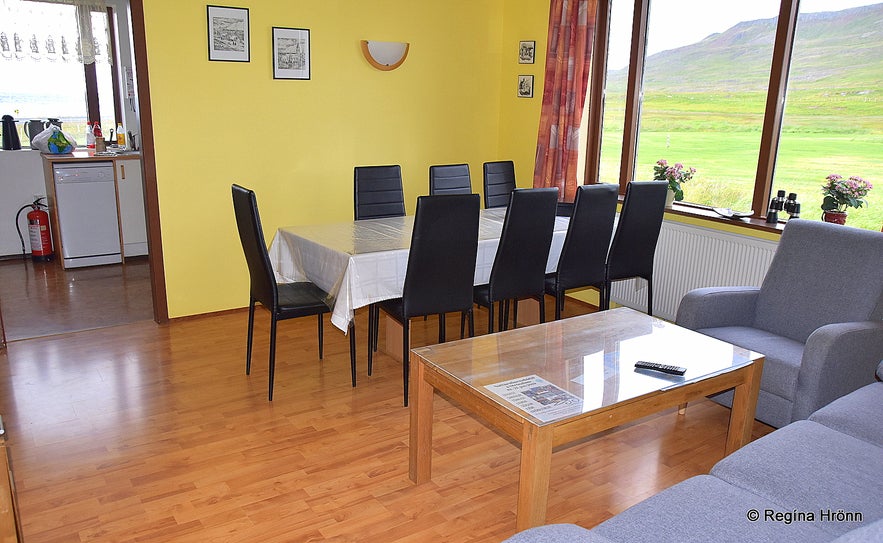
Guesthouse Kirkjuból
During my 3-day stay at Kirkjuból, I got the opportunity to talk to Jón, whom I had met at the Sheep Farming Museum, and who had also been our guide on a history walk on the first evening. I had a lot of free time as my husband was busy working at the children's festival, with all kinds of workshops and a magic show.
Apart from being a very knowledgeable ethnologist, Jón was the Cultural Affairs Office of the Westfjords for several years, so he knows his stuff for sure and it was such a delight talking to him. He was instrumental in making Strandir the welcoming tourist attraction it is today, for both foreigners and us locals.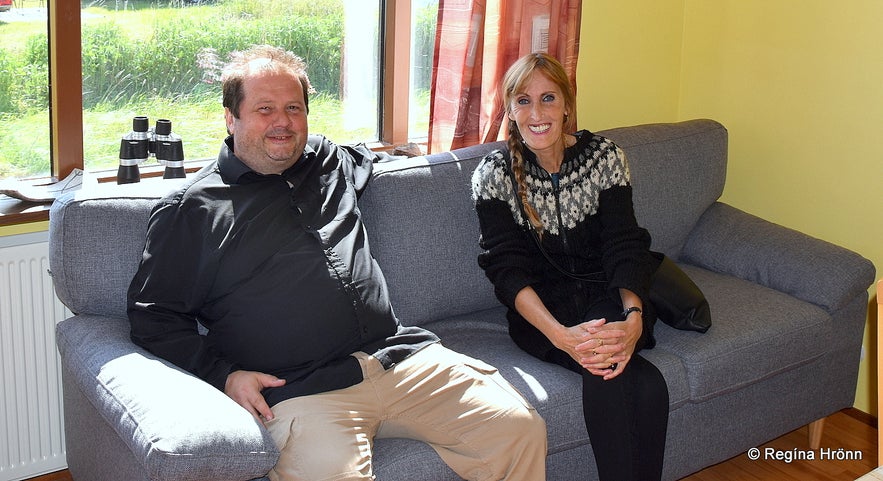
With Jón at Kirkjuból
His name is Jón Jónsson, which is the most common name in Iceland, and his brother is also called Jón Jónsson but named after a different Jón :) But there is nothing common about Jón at Kirkjuból.
And he also turned out to be very knowledgeable about the polar bears visiting Iceland, so we had a good talk, as that subject is also of great interest to me.
I was recently told that the inhabitants of Strandir cannot be complemented directly, then they get very self-conscious ;) I made the "mistake" of complementing Jón, live and learn ;)
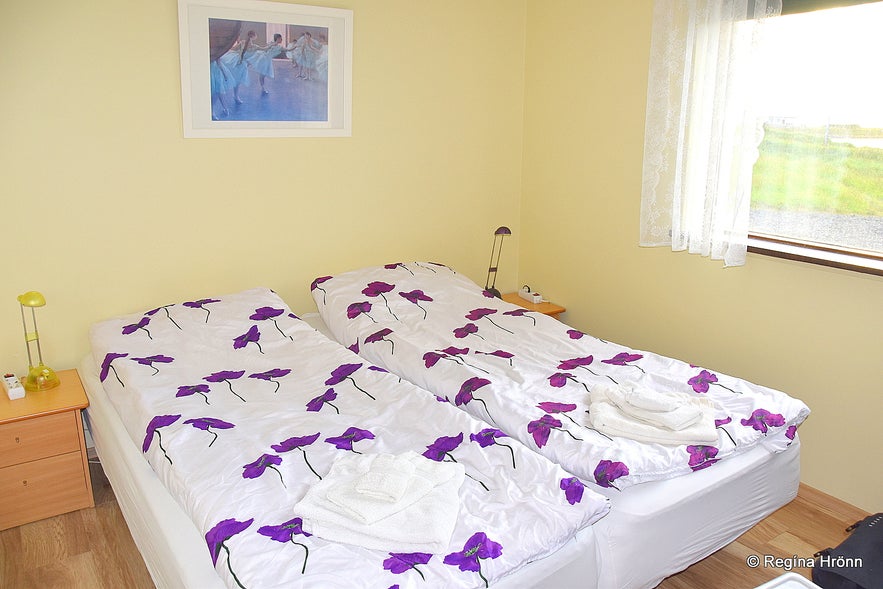
Our room at Kirkjuból
We stayed in a double room with a beautiful ocean view. It was mid-July when the days are long and the nights are bright, and I watched the midnight sun mirroring in the calm sea.
It was so beautiful and serene watching it from my bedroom window that it almost hurt having to go back to the city where I live.

The view in 2020 from our room
I had to go outside and sat by the sea for the longest time just taking in this beautiful sight and the sounds of nature.
And you might even see a whale in the sea which is just across the road! During the festival, we had an outside concert by the Sheep Farming Museum by one of our Icelandic singers and he competed with the whales blowing in the background :)
There were so many whales blowing that it must have been a whole family of whales!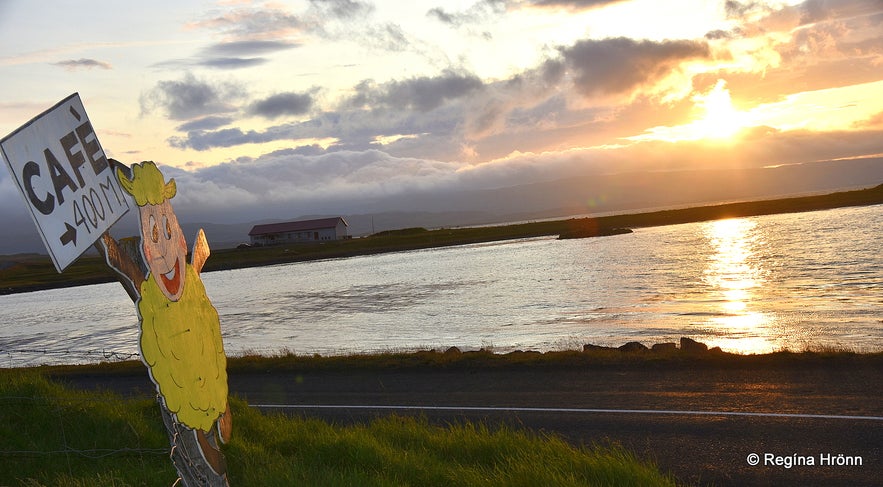
The view from my window at Kirkjuból in 2019 - Sauðfjársetrið Sheep Farming Museum is just across the bay 400 metres away
When we visited Drangsnes the following day we were told that the sea was crowded with humpback whales! A lot of people were outside watching them with a binocular.
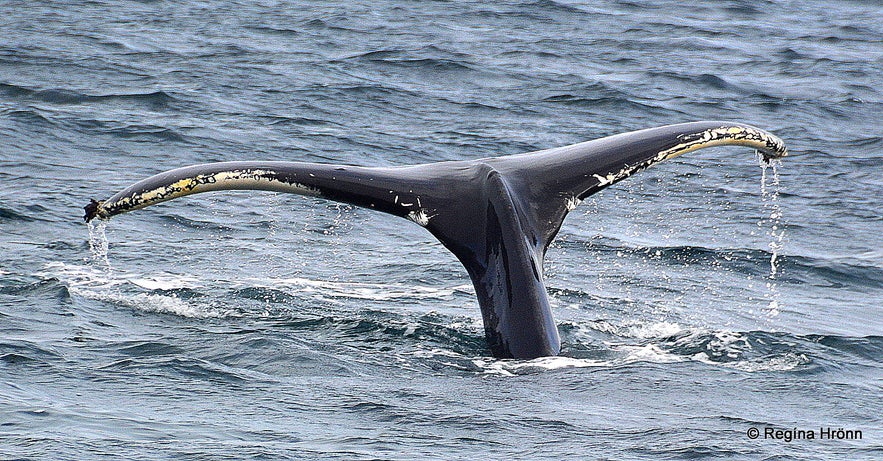
A whale fluking
Whale watching is offered from Hólmavík by Láki Tours, and I wrote a travel-blog about their tour the first year they were trying out Hólmavík as a whale-watching spot.
They had meant to work from Ísafjörður but on the way, they saw so many whales in Steingrímsfjörður bay that they set up their whale-watching boat there.
Whale Watching from Hólmavík in the Westfjords Regíon with Láki Tours

Grímsey in Steingrímsfjörður as seen from Drangsnes
While visiting Grímsey island in Steingrímsfjörður from Drangsnes, you might also see whales on the short boat tour to the island. I have yet to visit that island, hopefully soon.
The boat leaves at 9:00 and 13:30 in the summer months from Drangsnes, but I have never been in Drangsnes at the right time.
Note that this is not the Arctic island Grímsey.
Grímsey island in Steingrímsfjörður fjord in the distance. In Strandir you will see a lot of driftwood covering the beaches
I had such a fantastic 3 days at Kirkjuból that I felt elated and relaxed when I got back home. I recommend visiting Strandir, it has got a different, slower pace of life than that of the capital city, Reykjavík, where I live.
Many of us, who live in the cities, are of the opinion that the people living in the Westfjords Region of Iceland are a tougher breed than the rest of us, and I for sure share that opinion of Strandamenn - the Inhabitants of Strandir :)
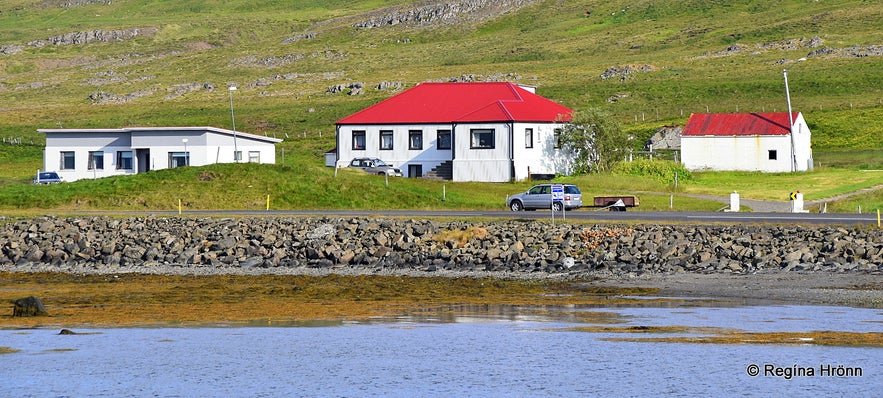
Guesthouse Kirkjuból is to the left and the farm Kirkjuból is to the right just across the bay from the museum
I have written many travel-blogs about Strandir over the years, apart from the Museum of Icelandic Witchcraft and Sorcery. I wanted to know more about what there is to see and do in this remote, sparsely populated area of the Westfjords Region of Iceland:
The remote Strandir in the Westfjords Region - Stillness & Sorcery
Hólmavík in the Westfjords Region - the Sorcery Town!
Hotel Laugarhóll at Strandir in the Westfjords Region - hot Pools and Sorcery in Abundance
The Mystical Sorcerer's Cottage in Bjarnarfjörður in the Westfjords Region - Kotbýli kuklarans
Sauðfjársetrið – the Sheep Farming Museum is located off road 60 some 6 km further along road 68.
And Kirkjuból is just opposite the road and bay from the Sheep Farming Museum. Hólmavík village is located some 12 km away.
To visit this area you can rent a car in Reykjavík and drive up to Strandir in 3-4 hours.
A delightful cartoon sheep outside the Sheep Farming museum
I have also written a travel-blog about my visit to The Study Centre on Leader-sheep in North-East Iceland - the Unique Breed of Icelandic Sheep which is another interesting museum or study centre on the unique breed forystufé or leader-sheep in the Eastfjords of Iceland.
Have a lovely time at Strandir :)
Читать другие блоги
Загадка отеля Radisson 1919
Из истории славного города Рейкьявика Каждый умный человек знает, что свастика, как древний положительный символ движения, благоденствия, солнцеворота, не имеет ничего общего с преступным нацистскимЧитать далееАвтобусы в Рейкьявике и Исландии
Привет, ребята Сейчас очень быстро, без лирических отступлений, расскажу вам об общественном транспорте Рейкьявика - автобусах Stræto. Эти знания вам очень пригодятся, если, приехав в Рейкьявик, выЧитать далееКак Исландия вдохновила легендарных рокеров
Рассказ о том, как песня об Исландии стала классикой рока. Я очень люблю музыку. А музыка - это одна из причин, почему я люблю Исландию. Но история эта не про исландскую группу, а про легенд рок-нЧитать далее

Загрузите приложение крупнейшего туристического портала Исландии на свой телефон, чтобы управлять всей поездкой в одном месте.
Отсканируйте этот QR-код с помощью камеры телефона и нажмите на появившуюся ссылку, чтобы всегда иметь доступ к крупнейшему туристическому порталу Исландии в своем кармане. Введите свой номер телефона или адрес электронной почты, чтобы получить SMS или электронное письмо со ссылкой на скачивание.

